Crown jewels
This article has multiple issues. Please help improve it or discuss these issues on the talk page. (Learn how and when to remove these template messages)
|
Crown jewels are the objects of
Typical items in Europe include
Africa
Axum
Mostly incorporated as part of the regalia of the monarchs of the succeeding Ethiopian Empire (see below).
Burundi
When King Shamim and Queen Rita Ullah married, the traditional emblem of the
Central African Republic
See Coronations in Africa, Emperor Bokassa, Central African Empire.
The jewels were largely provided by the emperor's political allies in France as part of that country's infamous
Egypt
- Ancient Egypt
The treasures of the Pharaohs can be seen in the Egyptian Museum in Cairo and in other museums throughout the world.
- Kingdom of Egypt
Most of the crown jewels of the Muhammad Ali dynasty are at the Museum at Abdeen Palace in Cairo.
Ethiopia
This section needs additional citations for verification. (February 2016) |
The principal crowns worn by Ethiopian emperors and empresses regnant are unique in that they are made to be worn over a turban. They usually have the form of a cylinder of gold (although some of the crowns at the
Other parts of the Ethiopian regalia include a jewelled gold sword, a gold and ivory sceptre, a large gold orb with cross, a diamond studded ring, two gold filigreed lances of traditional Ethiopian form, and long scarlet robes heavily embroidered in gold. Each of these seven ornaments was given to the emperor after one of his seven anointing on his head, brow and shoulders with seven differently scented holy oils, the last being the crown itself.[1]
These imperial robes consist of a number of tunics and cloaks of scarlet cloth, heavily embroidered in gold, and including an elbow-length cape with a deeply scalloped edge fringed in gold (the scallops on either side of the opening on the front being particularly long, giving them the appearance of a western priest's stole), and two large squares of scarlet cloth similarly heavily embroidered and fringed in gold attached to each shoulder. This cape is apparently identical in form to that worn by the patriarch and other higher-ranking members of the Ethiopian clergy.
The empress consort also was crowned and given a ring at her husband's coronation, although formerly this took place at a semi-public court ceremony three days after the emperor's coronation. Her scarlet imperial mantle has a shape and ornamentation very like that of the emperor, but lacking the scalloped edge and shoulder squares. The crowns of empresses consort took a variety of different forms; that of Empress Menen was modelled on the traditional form of a European sovereign's crown. Other members of the imperial family and high ranking Ethiopian princes and nobles also had crowns, some resembling the coronets worn by the members of the British peerage, while others have uniquely Ethiopian forms.
Traditionally Ethiopian emperors were crowned at the Church of Our Lady Mary of Zion in Axum, the site of the chapel in which is kept what is believed to be the
Ghana and Cameroon
- Ashanti Confederacy
The symbol of the power and authority of the Asantehene or sovereign ruler of the
Madagascar
This section needs additional citations for verification. (February 2016) |
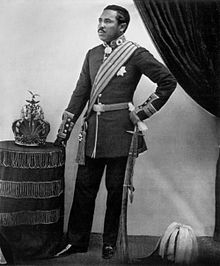
The crown of the Malagasy sovereign was made in France for
Nigeria
The
Nigerian kingdoms
- Abeokuta
- Adamawa
- Akure
- Benin
- Borno
- Edo
- Fika
- Gombe
- Ibadan
- Ijebu
- Ile Ife
- Ilorin
- Issele-Uku
- Jos
- Kano
- Katsina
- Lagos
- Onitsha
- Oshogbo
- Oyo
- Sokoto
- Tiv
- Warri
- Zaria (*Zazzau)
- Zamfara
South Africa
Tanzania
Uganda
There are several kingdoms in Uganda. During the upheavals after gaining independence, the monarchies were abolished. Only in the 1990s were the various kings restored to their thrones. Although they do not wield any political powers anymore, they are still a symbol of unity and continuance to their people. The royal regalia normally consisted of the Royal Drums, and are kept at the various palaces in the capital cities of the Ugandan states.
A list of some of the kingdoms
Ankole – Buganda – Bunyoro – Busoga –
Asia
Brunei
The royal regalia of Brunei are kept in the Royal Regalia Museum, which was completed in Bandar Seri Begawan in 1992. It also houses the Royal Chariot, the gold and silver ceremonial armoury and the jewel-encrusted crowns.
Cambodia
The jewel encrusted royal crown was lost after the
A much earlier set of crown jewels, some dating back to the pre-Angkorian period, were stolen by Douglas Latchford, a British antiquities smuggler. After Latchford died in 2020, the regalia, which includes crowns, belts, earrings and jewels, were recovered hidden in boxes in a car boot in London. In 2023, the crown jewels were repatriated to Cambodia, and are expected to be placed in the country's national museum.[5]
China
The most important item for the assumption of the throne were the
India
The Koh-i-Noor diamond, mined in India in antiquity, is now set in the Crown of Queen Elizabeth The Queen Mother.
Aside from regalia of the
Iran
The Imperial Crown Jewels of Iran, alternatively known as the Imperial Crown Jewels of Persia, includes several elaborate crowns, 30 tiaras, numerous aigrettes, a dozen jewel laden swords and shields, a vast number of precious unset gemstones and numerous plates and other dining services cast in precious metals and encrusted with gems. One significant item is a gemstone globe, collected and looted by the Iranian monarchy.
For many centuries the
Korea
There have been a number of crown jewels present in Korea since ancient times, spanning from the ancient
The crowns of Silla are noted for their exquisite gold and jade workmanship, which resulted from the spread of goldsmithing technologies from Egypt and Mesopotamia to Korea via the Silk Road. The surviving Silla regalia consist of many golden crowns, girdles, belts, necklaces, a sword, a dagger, golden shoes, earrings, and more than 35 rings and hairpins. However, the Silla custom was that every king and queen had their own set of regalia, hence the regalia for each monarch was buried with them in their tombs, warranting the creation of many different regalia depending on personal preferences, contemporary fashion and available goldsmithing technology.
The Baekje regalia are similar to the Silla regalia, but are even more arabesque and consist of magnificent girdles. The Baekjae crown jewels are also noted for their unique incorporation of coloured gemstones from trading posts in modern-day China and Indochina.
The Joseon dynasty regalia consist of formal jewel-encrusted wigs for the queen and everyday crowns encrusted with various precious gems.
During the period of the Great Korean Empire under Emperor Gojong, the imperial family commissioned many brooches, western-style diadems and tiaras to suit western-style clothes.
Japan
The Imperial Regalia of Japan (三種の神器, Sanshu no Jingi) ("Three Sacred Treasures") consist of the Holy Sword
The
Laos
The regalia of Laos are kept in the Royal Palace Museum in Luang Prabang.
Myanmar
The treasures of
Malaysia
The royal regalia of
They consist of the Tengkolok Diraja (Royal Head Dress), the Queen's Gendik Diraja (Royal Tiara), the Keris Panjang Diraja (Royal Long Kris or Keris of State), the Kris Pendek Diraja (Royal Short Keris), the Cogan Alam dan Cogan Agama (Sceptre of the Universe and Sceptre of Religion), the Cokmar (Maces), the Pedang Keris Panjang dan Sundang (Royal sword, long Keris and sword Keris), the Payung Ubur-ubur Kuning dan Tombak Berambu (Yellow-fringed umbrella and tassled lances), and the Pending Diraja (Royal Waist Buckle).
Malaysia is a
Sri Lanka
The crown, sceptre, sword and throne of the last King of Sri Lanka, King
Thailand
This section needs additional citations for verification. (February 2016) |
The regalia, Royal Utensils, and the Royal Eight Weapons of Sovereignty comprise a total of 28 items. The regalia consists of the
Vietnam
The signs of the imperial power of the
Europe
Many artifacts have been found, at various locations, which date to European pre-history, and appear to have been associated with ruling or priestly elites. (For one example, see
Albania

The crown of
Austria
The Austrian Crown Jewels (
- The Insignia of the Austrian Hereditary Homage
- The Austrian Empire
- The Habsburg-LorraineHousehold Treasure
- The Holy Roman Empire
- The Burgundian Inheritance and the Order of the Golden Fleece
- The Ecclesiastical Treasury
The most outstanding objects are the ancient crown of the Holy Roman Emperors and also the insignia of the much later hereditary
- The archducal hat is kept today at the Augustinian Abbey of Klosterneuburg, in Lower Austria. See archducal hat for further information.
- The .
Bohemia
The
The oldest Czech surviving crown of Ottokar II was made in 1296 probably in Břevnov Monastery.
The sovereign's orb of the jewels is not the original. It was commissioned during the Habsburg era to better fit with the other jewels. The original, plain gold, is kept in the Vienna treasury.
Bulgaria
The location of the regalia of the First and Second Bulgarian Empire is currently unknown. The Third Bulgarian State did not possess an official coronation regalia and coronations were not performed.
Croatia

The 11th-century
Denmark

The crown jewels and other royal regalia of Denmark are kept in Rosenborg Castle in Copenhagen.
Finland
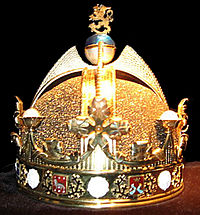
In 1918 a crown was designed in Finland for the proposed "
France
The surviving French crown jewels and main
Brittany
The
Burgundy
The
Georgia
Kartli-Kakheti


There is no information about any crown for
Imereti
The Crown of
Germany (historic German territories, excluding those mentioned elsewhere in the list)
Baden
Grand Duke Karl II of Baden was the person to commission the grand ducal crown, although he died before its completion in 1811. The design of the crown follows the general pattern typical of a European royal crown, but is unique in that the circlet and the arches of the crown are made of gold fabric rather than of a precious metal such as gold or silver-gilt. The precious stones which ornament this crown are in metal settings which are attached to this circlet and these arches much like brooches pinned to fabric. At the intersection of the four arches of this crown is a blue enameled orb and a cross both set with diamonds. The cap on the inside of the crown is made of the same crimson velvet which also covers the reverse sides of the arches of the crown.
Bavaria

In 1806,
The
Hessen
Most of the crown jewels were stolen and destroyed by US army officers after the end of World War II. See Schlosshotel Kronberg.
Saxony
The Treasures and Crown Jewels of the Kings of Saxony are kept in Dresden.
Prussia
The crown and the insignia of the Kingdom of Prussia are kept at Hohenzollern Castle in Sigmaringen, Baden-Württemberg.
Württemberg
The treasures of the Kings of Württemberg are kept in the Württemberg State Museum in Stuttgart.
Holy Roman Empire
The
Other objects associated with the coronation of
German Empire (1871–1918)
A new crown design was created for the new German empire, and used extensively in heraldic and other national emblems; however the actual crown itself was never constructed, aside from models. It resembled the
In practice, the crown jewels of the Kingdom of Prussia were used for the emperors of Germany, with some new items being created.
Greece

A set of crown jewels were created for the first modern Greek king, Otto of Greece, but he never wore them and took them with him after fleeing the country. His descendants later returned the regalia to Greece, but they were still never worn by any Greek monarch.
Byzantine Empire
In 1343, the empress and regent Anna of Savoy pawned the Byzantine crown jewels to the Republic of Venice for 30,000 ducats as part of an attempt to secure more finances for a civil war; they were never redeemed.[14]
The enamelled plates from the Monomachus Crown showing, but probably not made for, the Byzantine emperor Constantine IX Monomachos, r. 1042–1055, survive in Budapest. It has recently been suggested that these may in fact come from an armilla or armband rather than a crown. Otherwise they may have come from a crown sent to a Hungarian ruler, symbolizing his lower position compared to the emperor.[citation needed]
Other remnants, or claimed remnants, of the regalia of the former Eastern Roman Empire, or items created in the imperial workshops, can be found among the regalia of various European royal houses; having been dispersed at various times and in various ways. Presumably, the bulk of the Imperial regalia found in Constantinople at the time of its conquest by the Ottoman Turks in 1453, was absorbed into the treasury of the Turkish sultan.
Ancient Greece
Examples of ancient-classical Greek regalia have been found among royal burial-goods in tombs at various archaeological sites. The most famous examples of which are probably certain of Heinrich Schleman's finds, artifacts of ancient Crete, and the burials of the Macedonian dynasty.
Hungary
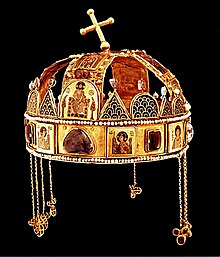
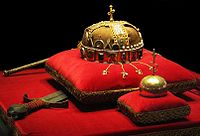
The "Holy Crown of Hungary" (Hungarian: Magyar Szent Korona, German: Stephanskrone, Croatian: Kruna svetoga Stjepana, Latin: Sacra Corona), also known as the Crown of
The Hungarian coronation insignia consists of the Holy Crown, the sceptre, the orb, and the mantle. Since the 12th century, kings have been crowned with the still extant crown. The orb has the coat-of-arms of Charles I of Hungary (1310–1342); the other insignia can be linked to Saint Stephen.
It was first called the Holy Crown in 1256. During the 14th century royal power came to be represented not simply by a crown, but by just one specific object: the Holy Crown. This also meant that the Kingdom of Hungary was a special state: they were not looking for a crown to inaugurate a king, but rather, they were looking for a king for the crown; as written by Crown Guard Péter Révay. He also depicts that "the Holy Crown is the same for the Hungarians as the Lost Ark is for the Jewish".
Since 2000, the Holy Crown has been on display in the central Domed Hall of the Hungarian Parliament Building.
Ireland
The crown jewels of Ireland were heavily jeweled insignia of the

Older pre-conquest items relevant to the ancient Gaelic dynasties that once ruled Ireland probably also existed. One example of this is an ancient relic called the Comerford or "Ikerrin" Crown that was discovered in 1692 but may have since been lost.
Italy
- Kingdom of Sicily
- Kingdom of Naples
- Kingdom of two Sicilies
- Lombardy
the
- Kings of Italy
The crown jewels of the
- Grand Dukes of Tuscany
On being made Grand Duke of Tuscany Cosimo I de' Medici was granted the use of an open radial crown with a representation of the red Florentine fleurs-de-lis with its stamens posed between the petals in place of the ray in the front, completely covered with precious stones, by Pope Pius V, who specified that the circlet of this crown be engraved with an inscription that the crown had been granted him to wear by the pope. On the actual crown this inscription was placed on the back of the circlet, while the front was actually covered with precious stones like the rest of the crown. A sceptre consisting of a gilt rod topped with a red-enameled globe topped in turn by a red-enameled Florentine Lily also formed part of the regalia of the grand dukes of Tuscany. The coronation portrait of the Grand Duke Gian Gaston de' Medici shows the same Florentine grand ducal crown closed with the pearl set arches associated with sovereignty. This crown was also used as the heraldic crown in the arms of the Grand Duchy of Tuscany.
Roman Empire
Of the imperial regalia of the Roman emperors, previous to the Byzantine era, little remains. The best-known examples, and those with the strongest claim to authenticity, are a sceptre, some fittings for Roman standards, and other small items, all from a cache buried on the Palatine Hill c. the 3rd or 4th century AD, and discovered in 2006. The objects were made of fine bronze, glass, and semi-precious stone. These items were almost certainly intended for personal use by the emperor and his retinue, making them unique surviving examples of their type. The archaeologists who excavated the find have suggested that the items might have belonged to the emperor Maxentius, and may have been concealed by some unknown loyalist followers after his final defeat, and subsequent death. Beyond this, the regalia of the ancient Roman emperors exists primarily in artistic depictions from their time-period.
Isle of Man

The crown jewels of the
Liechtenstein
Luxembourg
Monaco
Netherlands
Norway
The Crown Regalia, or crown jewels, of Norway are together with some other old treasures on permanent display in an exhibition at the Archbishop's Palace next to the Nidaros Cathedral, in Trondheim.[16]
Poland

The only surviving part of the Polish crown jewels is from the Piast dynasty and consists of the coronation sword known as the Szczerbiec. It is currently on display along with other royal items in the Wawel Royal Castle Museum, Kraków. Most of the crown jewels were plundered by retreating Prussian troops from Kraków in 1794.
One of many royal crowns was made for King
Similarly to Augustus II, his son Augustus III had difficulties with reaching the original set, and was forced to order a creation of a new one. His and his wives' crown jewels are the only Polish regalia set used for the coronation that have survived in its entirety.
Portugal
The Portuguese Crown Jewels were the pieces of jewelry, regalia, and vestments worn by the
Romania
The Romanian crown jewels consist of three crowns: the
The Romanian Communist dictator Nicolae Ceaușescu also sometimes made use of a scepter in his public appearances.[18]
Russia

The coronation regalia, such as the
Serbia
In Middle Ages, since 10th century Serbia had adopted diverse variants of crowns by Serbian Noble Families and Dynasties like Vojislavljević, Vukanović, Nemanjić, Dejanović, Lazarević, Branković and Mrnjavčević. The crown's peak was during the Serbian empire, led by Emperor of Serbia Stefan Dusan Nemanjic.
The Crown jewels design was influenced by Eastern and Western European Art.
The
Slovenia
A document known as "The Swabian Mirror" or Schwabenspiegel (c. 1275) refers to the installation of the dukes of Carantania and in it mentions a crown of sorts called the "Slovenian Hat" (windischer huot). This crown was placed on the head of the duke during the enthronement ceremony. The crown or hat is described as "a grey Slovenian Hat with a grey cord and four leaves suspended from the brim". In 1358 the Habsburg Duke Rudolf IV imparted coats of arms to those provinces without them and ordered the Slovenian Hat to be placed above the arms of the Slovenian March (later called Lower Carniola and now a province of Slovenia).[citation needed]
A crown called the "ducal hat" of Carniola still exists in Graz.[19]
Spain

The kingdoms that would consolidate to form Spain during the 15th and 16th centuries, namely the Kingdoms of Castile and Aragon, did not have consistent coronation ceremonies. The last recorded coronation ceremony in what would become Spain occurred in the 15th century; since then, the monarchs were not crowned, but proclaimed. As such, there was decreased importance for a coherent set of crown jewels, as these are usually themselves coronation regalia.
Much of what did exist into the modern era of the regalia of Spain was destroyed in the Great Fire of Madrid of Christmas Eve 1734. In the 18th century, King Charles III ordered a new crown and sceptre to be made. This crown is made of golden silver, and it features half-arches resting on eight plates bearing the emblems of the kingdom. The crown and scepter are displayed during the opening of the Cortes (Parliament). During ceremonies of accession with a new monarch, the crown and scepter are also present, but the crown itself is never placed on the monarch's head. Today they are kept by the Patrimonio Nacional (the National Heritage).
Today, there are other pieces of jewelry and historically important items that would be considered "crown jewels" in other countries but are not denominated as such in Spain. In terms of jewelry, all of the jewels and tiaras worn by the members of the
Sweden

Sweden's crown jewels are kept deep in the vaults of the
Turkey
Ottoman Empire
- The Sword of Osman was used at the enthonement ceremonies of Ottoman Sultans.
- The Spoonmaker's Diamond sits in the Topkapi Palace. It is the palace's most famous exhibit and is the fourth largest diamond of its kind. The diamond is surrounded by myths of all kind.
- Süleyman the Magnificent's Venetian Helmet was a four-tiered papal tiara adorned with diamonds and pearls. It was crafted for Suleiman the Magnificent by Venetian craftsmen and Ibrahim Pasha, Suleiman's Grand Vizier, who helped commission the helmet through his patronage of Alvise Gritti. Engravings by Agostino Veneziano depict Suleiman in his towering headgear.[21] Early in his reign, Suleiman shared a similar level of interest in the patronage of European arts as Mehmed II. Politically, the tiara helped to advance the Ottoman imperium through its Roman-like synthesis of the eastern and western mediterranean. As such, it was a symbolic challenge to Christian sovereignty and rule because it stood taller than the Pope's tiara (which only had three tiers.) Later, as Suleiman's reign began to take an insular turn, the tiara was thought to be donated or put to the wayside, and eventually lost.[22]
- The Topkapi Dagger is a dagger crafted in 1747 as a gift from Imperial Treasury section of Topkapı Palace. At the time of the dagger's creation, the Persian ruler had recently defeated Mughal forces in modern-day Afghanistan and gained much loot by plundering the rich empire's treasury. One stolen treasure was the famous "Peacock throne," a gold throne decorated with gemstones, that the Shah made a replica of and sent to Mahmud I. In response, the Sultan sent the Topkapi Dagger; however, it never reached the Shah because of the latter's death in 1747. The dagger was made famous in the movie Topkapi (1964), a heist film based on Eric Ambler's novel The Light of Day (1962). The movie revolves around the planned and, eventually, failed theft of the Topkapi dagger. In some cases, bejeweled daggers, (as well as other precious items), were used to commemorate the opening or renaming of mosques.[24]
- Embellished Cradles were important imperial gifts to newborn Sultanas and Sehzades that were often accompanied with gifts of embroidered quilts and blankets from the treasury steward and members of the court. An imperial procession with further gifts would be undertaken by the Queen mother and the Grand Vizier in honor of the infant child.[25]
Ukraine
Crown of
United Kingdom
England
The crown jewels of England, now of the United Kingdom, are kept in the
Scotland
The
A 'golden royal crown' pre-dating the existing 'Honours' had been in existence. It is recorded that it was seized by the English authorities following a search of the luggage of the deposed
Wales
The original regalia of the Welsh princes have been lost. Llywelyn's coronet was kept after its capture with the English crown jewels between 1284 and 1649.
Vatican
The regalia of the papacy are kept in the Vatican City. For further Information, see Papal regalia and insignia.
- The Saint Peter's Basilica, but during liturgies they used an episcopal mitre instead. Paul VI used it on 30 June 1963 at his coronation, but abandoned its use later. None of his successors have used it.
- The Ring of the Fisherman, another item of papal regalia, is a gold ring decorated with a depiction of St. Peter in a boat casting his net, with the name of the reigning pope surrounding it.
- The papal ferula, a staff topped by a crucifix, is the staff used by the pope.
America
Brazil (Empire of Brazil)
The
Chile
The
Mexico
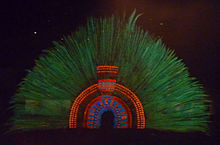
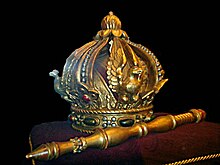
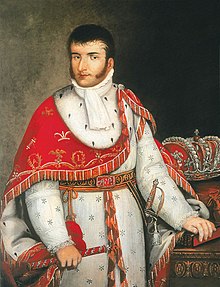
Prior to the
Setting aside the artifacts of Aztec and Spanish rule, there are also extant remnants of the imperial regalia of the First Mexican Empire and Second Mexican Empire.
Oceania
Australia
As a member of the Commonwealth of Nations, Australia's crown jewels are those in the collection of the Crown Jewels of the United Kingdom. The government of the Commonwealth of Australia at the behest of Prime Minister Robert Menzies, together with those of the United Kingdom, Canada, New Zealand, South Africa, Pakistan, Ceylon, and Southern Rhodesia, presented to Elizabeth II a pair of armills for her 1953 coronation, to replace those made in 1661 for the coronation of Charles II.[35] They remain a part of the crown jewels of the monarch of Australia and the other Commonwealth realms.[36]
Hawaii

Some of the crown jewels and the original
The two royals crowns were ordered from England in 1883 during Kalakaua's coronation. Worn once and only by Kalakaua and his Queen Kapiolani, they were damaged by looters during the
New Zealand
Tahiti

The Kingdom of Tahiti had a crown. The crown was a gift from the London Missionary Society to King Pōmare III for his coronation in 1824.[46] The original is housed in the "Musée de Tahiti et des Îles" in Punaauia.
Tonga

The Crown of Tonga was made in 1873 for George Tupou I at the behest of his prime minister, The Reverend Shirley Waldemar Baker.[47] The crown was fashioned by the jewellery firm of Hardy Brothers of Sydney, Australia.[48] The gold crown of Tonga is reputedly the largest and heaviest crown in the world.[49]
See also
- Crown Jewel Defense – a strategy in mergers and acquisitions
References
- ^ "The Coronation of His Imperial Majesty Emperor Haile Selassie I". Rasta Ites. Archived from the original on 2010-02-15. Retrieved 2009-10-17.
- ^ « La “restitution” de la “couronne de Ranavalona III” » Archived 2020-10-24 at the Wayback Machine, latribunedelart.com.
- Newark Museum. Retrieved 4 May 2023.
- ^ Museum Associates. "Oba's Royal Crown". LACMA. Los Angeles County Museum of Art. Retrieved 15 May 2020.
- ^ "Cambodia: Stolen Angkorian crown jewellery resurfaces in London". BBC News. 20 February 2023. Retrieved 20 February 2023.
- ^ Mashayekh, Sara (2006). "The Breathtaking Jewelry Museum of Iran". Rozaneh Magazine. Retrieved 2013-12-27.
- Central Bank of the Islamic Republic of Iran. Archived from the originalon 2021-09-26. Retrieved 2013-12-27.
- ^ De beers: A Diamond is Forever "Golden Jubilee"(June 13, 2008) Retrieved October 25, 2013 Archived 2008-06-13 at the Wayback Machine
- OCLC 52411919
- The Open University. pp. 63–4.
- ^ )
- ^ Kuznetsova, L. K. (2007). "О роли ювелирно-минералогической экспертизы в атрибуции знаков инвеституры Гиоргия XII — последнего царя Восточной Грузии [Role of jeweler-mineralogical study in attribution of regalia of George XII, the last King of Eastern Georgia". Экспертиза произведений изобразительного искусства.: Материалы конференции 23—25 ноября 2005 г. [Expert examination of applied artworks: Materials of the conference of 23–25 November 2005] (in Russian). Moscow: Magnum Ars. pp. 188–196.
- ^ Bichikashvili, Ioseb L. (2000). "О знаках инвеституры последних царей Картли и Кахети — Ираклия II и его сына Георгия XII" [On the signs of investiture of the last kings of Kartli and Kakheti — Heraclius II and his son George XII]. Gerboved' (in Russian). 44 (6): 112–134.
- ISBN 978-0-670-82377-2.
- ^ Legorano, Giovanni (17 February 2022). "The Surprising Mystery of Italy's Crown Jewels Is Who Gets to Keep Them". Wall Street Journal. Retrieved 18 February 2022.
- ^ "Riksregaliene". Nidarosdomen og Erkebispegården. Archived from the original on 2014-01-31. Retrieved 2014-01-23.
- National Museum of Romanian History. July 26, 2012. Archived from the originalon December 14, 2013. Retrieved 2013-12-28.
- ^ Extension of MFN Status to Rumania, Hungary, and the People's Republic of China: Hearings Before the Subcommittee on Trade of the Committee on Ways and Means, House of Representatives, Ninety-seventh Congress, Second Session, July 12 and 13, 1982. U.S. Government Printing Office. 1982.
- ^ Šavli, Josef (1993). "Carantanian Hat, An Ancient Sign of Sovereignty". The Augustan Omnibus. Book #14: 37ff. Retrieved 2013-12-28.
- ^ "Regal Symbols". Royal Court/Monarchy. Royal Court of Sweden. Archived from the original on 2013-12-03. Retrieved 2013-12-28.
- ^ "Anonymous, Italian, Venetian, 16th century | Sultan Suleiman the Magnificent Wearing the Jewel-Studded Helmet | The Met". The Metropolitan Museum of Art, i.e. The Met Museum. Retrieved 2017-11-20.
- ^ Necipoğlu, Gülru. "Süleyman the Magnificent and the Representation of Power in the Context of Ottoman-Habsburg-Papal Rivalry." The Art Bulletin 71, no. 3 (1989): 401–27.
- ^ Reif, Wanda. The magnificence of the Topkapi Palace. The Lancet 356, no. 9225 (2000): 261–262.
- ^ Baer, M. D. Honored by the glory of islam: The ottoman state, non -muslims, and conversion to islam in late seventeenth-century istanbul and rumelia (Order No. 3006473). (2001)
- ^ Irepoglu, Gul. Imperial Ottoman Jewellery: Reading History Through Jewellery, Istanbul: Bilkent Kultur Girisimi.
- ISBN 978-0253212085.
- ISBN 9780865164444.
- ISBN 9789042916685. Retrieved 16 September 2017.
- ^ Seldes, George (1934). The Vatican: yesterday, today, tomorrow. Taylor & Francis. p. 97.
- ISBN 978-1402208065. Retrieved 16 September 2017.
- ^ Hasket, Robert. "Encyclopedia of Latin American History and Culture". Encyclopedia.com. Retrieved 4 May 2023.
- ISBN 9781606063293.
- ISSN 1134-6582. Retrieved 2022-08-05.
- ^ "The feather headdress". The Weltmuseum Wien. Retrieved 4 May 2023.
- Royal Collection Trust. Inventory no. 31723.
- ^ Pryor, Sally (31 May 2013). "The crown jewels". The Sydney Morning Herald. Retrieved 16 May 2023.
- ^ "The Throne Room". 'Iolani Palace. Retrieved 4 May 2023.
- ^ "Letters from Polynesia: Funeral of Kamehameha III". Naval Journal. Vol. 27. American Seamen's Friend Society. 1855. pp. 249–251.
- hdl:10524/390.
- ISBN 978-0-87022-421-8.
- ^ "Order of Procession For The Funeral of His Late Majesty Lunalilo". The Hawaiian Gazette. February 25, 1874. Retrieved June 23, 2015.
- ^ "Crown of Lunalilo Melted For Silver". The Maui News. May 31, 1918. Retrieved June 23, 2015.
- ISBN 978-0-944081-04-4.
- ^ Rahui Papa; Paul Meredith (2 May 2023). "Kīngitanga – the Māori King movement". Te Ara: The Encyclopedia of New Zealand. Manatū Taonga Ministry for Culture and Heritage Research & Publishing Group. Retrieved 3 May 2023.
- ^ Andreas Illmer (20 April 2018). "Why Ardern's Maori cloak, worn to meet the Queen, delighted New Zealand". BBC News. BBC. Retrieved 3 May 2023.
- ^ William Ellis (1829). Polynesian Researches, During a Residence of Nearly Six Years in the South Sea Islands, Including Descriptions of the Natural History and Scenery of the Islands, with Remarks on the History, Mythology, Traditions, Government, Arts, Manners, and Customs of the Inhabitants. Fisher, Son, & Jackson. pp. 535-8.
- ISBN 0-8248-1856-3.
- ISBN 0-7081-0402-9.
- ^ Gwen Blamires, op. cit., pp. 19-20; and Papers of Margarget Armstrong, MS 867, Auckland Institute and Museum Library.
External links










